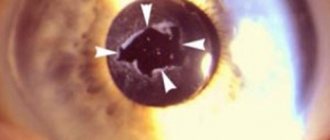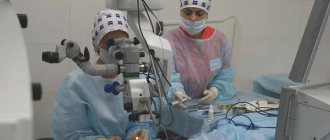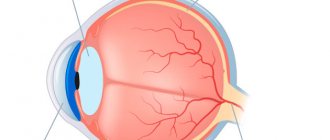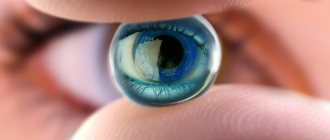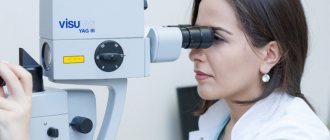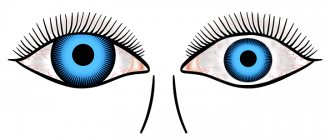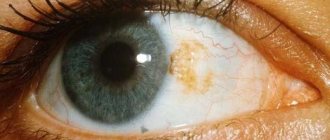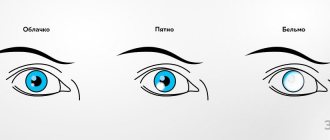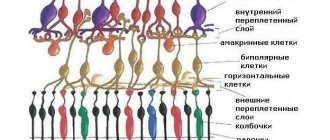Cloudiness of various layers of the lens is one of the causes of progressive vision loss. Posterior capsular cataract - damage to the posterior capsule with preservation of the transparency of the nucleus, occurs in elderly people. Often this type of pathology occurs due to general diseases (endocrinological, rheumatological) and in the working population. A characteristic feature of this disease is the possibility of its development after surgery to replace the cloudy lens with an intraocular lens.
Why do cataracts occur?
The causes of opacities on the posterior capsule include:
- Age over 40 years. Senile (senile) cataracts can occur according to this type.
- Rheumatological diseases: Still's disease;
- ankylosing spondylitis.
- systemic lupus erythematosus;
- diabetes;
Causes of fibrosis of the posterior capsule of the lens
Many factors influence educational status:
- residual clouding after completion of the procedure;
- low degree of qualification of the doctor;
- poor quality intraocular lens model;
- ophthalmological or systemic diseases that cause deterioration in the quality of vision, reduced supply of blood with nutrients and oxygen to the eyeball.
Before treatment, the doctor identifies the cause of the development of secondary cataracts. If it is a systemic disease, laser discision alone will not help.
Stages of cataract development
Doctors divide the stages of development of the disease in a patient.
The classification of lens opacities is based on the “maturity” of the disease. This is how the depth of the lesion and the effect on visual functions are conventionally distributed. The following stages of cataract development are distinguished:
| Stages | Visual acuity | Cloudiness | Complaints |
| Initial | 100 percent | Do not affect the area of clear vision, in the form of “spokes” | No |
| Immature | Up to 10 percent | Growth of “spokes” to the optical zone, their intersection | To a veil before my eyes |
| Mature | Counting fingers near the face, light | Diffuse opacification of the capsule | For a sharp decrease in vision |
| Overripe | Absent | Milky white lens bag | For lack of vision, pain in the eye (development of otalmohypertension) |
Posterior capsular cataract is distinguished by its lightning-fast course, when only a month can pass from the immature stage to the terminal stage.
Symptoms
The symptoms of primary and secondary cataracts are similar, as in both cases cloudiness occurs. This affects the following human functions:
- decreased visual acuity, which gradually progresses, leading to complete blindness without treatment;
- increased sensitivity to bright colors, glare in front of the eyes;
- frequent headaches that occur due to the fact that the patient overstrains the eye muscles;
- severe eye fatigue.
If a patient experiences these symptoms after phacoemulsification of a cataract, the doctor considers a diagnosis of a secondary disease. It can be confirmed based on instrumental examination methods.
How to recognize the disease?
At the first signs of vision problems, you should consult a doctor.
A progressive decrease in vision, fog or image distortion, without any accompanying symptoms, should prompt a person to visit a doctor, especially if there are risk factors for the disease. It is impossible to make a diagnosis on your own; a thorough ophthalmological examination is necessary.
Treatment of cataracts with folk remedies
When treating cataracts with traditional medicine, vision is not restored immediately, but after a certain period of time. However, the effect of healing infusions, decoctions and compresses is quite stable and permanent. The advisability of using herbal medicine as a treatment for this pathology should be checked with an ophthalmologist, since at certain stages only surgical intervention can help. Traditional methods in this case can only be used to restore the body after surgery, as well as to prevent further relapses.
Crowberry infusion
Crowberry helps restore visual acuity in case of cataracts and other eye diseases. To make a medicine, you can use both the roots of this shrub and its berries, as well as stems. It is recommended to mix all these ingredients, chop thoroughly and pour 1 tablespoon of raw material into 100 ml of boiling water. Cover the mixture with a lid and leave for 30 minutes in a warm place to infuse. After this, the liquid is squeezed out and filtered. Used as eye drops, 1 drop should be applied up to 5 times a day for 3 months.
Tincture of eyebright
This remedy can be used not only to treat cataracts, but also to prevent this disease. An alcoholic tincture of eyebright helps relieve dryness of the eyeball, restores vision, and reduces the rate of clouding of the lens. To make the medicine, you need to pour 100 g of pre-dried and crushed eyebright herb into 500 ml of alcohol. Leave the mixture in a hermetically sealed container for 2 weeks in a dark, dry place. Shake the ingredients from time to time. Then the finished tincture is carefully filtered and consumed orally, 2 teaspoons once a day. This solution should not be used to treat children or pregnant women.
Dill seeds
Dill seeds are often used to treat cataracts, as the substances they contain have a positive effect on vision. To prepare the remedy, you need to prepare dill seeds and put them in special small bags made of flannel cloth (about 3 teaspoons of seeds in each bag, no more than 5 cm in length and width). The preparations are lowered into a saucepan, poured with boiling water and placed on low heat for a few more minutes. After this, you need to wait until the compresses have cooled to a warm state and put them on your closed eyes, covering them with a warm cloth on top. You need to keep them for a quarter of an hour until they cool down. It is recommended to carry out this procedure at night.
Bird cherry for cataracts
If you experience problems with vision, if there is a risk of cataracts, as well as for its treatment, you can use an infusion of bird cherry flowers. To make a medicinal product, 10 g of collected flowers are poured into 250 ml of boiling water and left in a warm place for 20 minutes. Then filter the liquid, soak a cotton swab or piece of gauze in it and gently wash the eyes and the area around them. You can put gauze on top of your closed eyelids as a compress for 15 minutes.
Cornflower lotions
To make a healing infusion from cornflower flowers, you need to collect 1 tablespoon of blue inflorescences and pour 500 ml of boiling water over them. Then you need to wait until the liquid is infused and strain it. Soak a cotton pad in the prepared solution and make lotions for cataracts and other eye diseases. It is recommended to repeat the procedure no more than 7 times a day.
Blueberry tincture
Blueberries are a well-known remedy for restoring vision. To prevent cataracts, you can simply eat berries. To treat this disease, it is recommended to make a medicinal tincture. In this case, 200 g of freshly picked blueberries are poured with 100 ml of alcohol, tightly closed with a lid and left to brew for 3.5 hours. Then the drug is shaken and filtered. Take 10 drops orally 3 times a day before meals. This remedy is not suitable for treating children.
Collection of herbs based on horsetail
To make a medicinal decoction based on medicinal herbs, you need to prepare and finely chop pre-dried horsetail grass. Then it is recommended to mix 30 g of such raw material with 10 g of crushed fresh young nettle leaves and 15 g of knotweed herb. All ingredients are thoroughly mixed, after which 10 g of herbs are poured with 1 glass of water. Place the mixture on the stove until it boils, then reduce the heat to low and simmer for another 3 minutes. After this, the finished solution is cooled and filtered thoroughly. To get rid of cataracts, you need to take 100 ml of this decoction before meals once a day. The treatment period is from 2 to 3 weeks depending on the severity of the case.
Diagnostic methods
The examination begins with a medical history, since the disease is often associated with general pathological conditions of the body and injuries. Determining visual acuity will only allow you to suspect the presence of a problem. The main diagnostic method is biomicroscopy. Using a slit lamp, the doctor sees the eye in transmitted light with high magnification. It is with the help of this device that the condition of the lens and the degree of opacification are assessed. Diagnosing cataracts is not difficult, however, this disease makes further examination difficult. A cloudy lens does not allow assessing the condition of the fundus during routine ophthalmoscopy. This is important to consider in people with concomitant pathologies that complicate cataracts and are accompanied by changes in the retina (diabetes, arterial hypertension, macular degeneration).
Disease prevention
Preventive measures consist of a number of simple rules.
For example, while working at the computer you should take breaks and perform special gymnastics. Patients with such problems should use a humidifier if the room is too dry and heavy. Cosmetics must be of high quality and proven, so read the reviews before purchasing. Forget about care products that are sold in transitions or in small untested stores.
It’s better to spend money on high-quality cosmetics so that you don’t have to deal with puffy eyes and expensive treatment later. Be sure to take walks in the fresh air and sleep at least 8 hours. Avoid long periods of sleep as this can make you feel tired and lethargic.
You need to eat foods rich in vitamin B every day. These include a variety of dairy products, beans and liver. To prevent itchy skin, patients should practice standard hygiene and try not to rub their eyelids with dirty hands.
Ointments for bags under the eyes Treatment of macular degeneration of the retina, as well as symptoms and causes are presented here. Read the specifics of using the drug Arutimol according to the official instructions at this link.
Treatment of the disease
The drug may partially slow down the progression of the disease, but not stop it.
Posterior capsular cataracts can only be treated surgically.
Vitamin drops (“Katachrome”) can slightly slow down the progression of the pathology, but surgical intervention is still recommended in the future. Replacing the lens apparatus with an intraocular lens is carried out under local anesthesia and does not require long-term rehabilitation.
Eye workout
How can you do without exercise? The simplest gymnastics will be a useful addition:
- We sit down straight and stretch out a pen (pencil, felt-tip pen) in front of us. We move the object left and right, up and down, or in a circle.
- We look at the bright light for three seconds. Cover your face with your hands and relax. We repeat again. And so 15 times.
- We find an object that is far away and watch it for 10 seconds. We turn our gaze to a nearby thing.
- We keep our eyes open for a couple of seconds, then we squint and close them. Repeat 10–15 times.
Healthy foods
The body needs antioxidants to maintain eye health and prevent symptoms. The strongest are vitamins E and C. The carotenoids that make up the lens (zeaxanthin and lutein) are important. Therefore, food should contain large amounts of antioxidants.
It must be remembered that vitamin C is found in the following foods: lemon, strawberries, orange, greens, quince, peas, radishes, rose hips.
Folic acid (or vitamin E) can be found in: broccoli, pear seeds, sunflower seeds, sea buckthorn.
Zeaxanthin and lutein are found in: melon, apples, peaches, green peas, spinach, corn, pomegranate, beets, red grapes.
| Vegetables and fruits are extremely important in the treatment of lens disease. But don't forget about meat food. |
So, it will be useful to eat beef, chicken and rabbit. Fish and various seafood contain zinc, which has a significant effect on reducing the development of cataracts. If you choose between river and sea fish, then it is better to give preference to the second.
A few tips: food should be cooked in the oven or steamed, otherwise it will not be beneficial. Fruits and vegetables are healthier when eaten fresh, since with various processing the elements necessary for the body are simply lost.
Experts' opinion
Alexandra Arkadyevna, ophthalmologist
Unfortunately, cataracts are precisely the disease that can lead to complete loss of vision. It causes clouding of the lens, which is called the natural lens. The lens is able to change shape, thanks to which we see equally well near and far. When young, the lens is soft and elastic. With age, it loses its elasticity, becoming denser. That is why many people habitually believe that pathology is observed exclusively in old age. In fact, cataracts can develop in a young person who is completely healthy and strong, but has suffered some type of injury to the eye or head. Sometimes the disease is inherited, that is, it manifests itself in childhood. Such cases are rare, but not excluded.
How to get rid of the disease? An ophthalmologist will help with this. Treatment of ophthalmological pathology can only be surgical! Not a single drop prepared on the advice of grandmothers-healers will get rid of pathology. Compresses won't help either. If a person avoids medical intervention, trying to overcome the disease on his own, the situation can worsen sharply. It is possible that in record time a stage of cataract will come that even a doctor will not be able to cure.
Daria Nikolaevna, ophthalmologist
Among ophthalmological diseases, cataracts occupy a leading place. This is one of the most common problems encountered at any age. If there is a genetic predisposition, the disease can be diagnosed even in an infant. Meanwhile, age-related cataracts are more common, affecting people after 50.
If a person notices deterioration in night vision, poor perception of the color palette, or the appearance of streaks or spots before the eyes, it is better not to hesitate to contact the clinic. The main sign of cataract development is clouding. A person begins to see through “foggy glass,” which negatively affects the psycho-emotional state.
Attempts to eliminate the disease using traditional medicine will lead nowhere. Is it just for the worse? It can only be cured by surgery.
Volkov Sergey Vladimirovich, professor of the department of allergology and immunology, founder of the website nodoctor.ru
Today, cataracts are quite common. In most cases, among older people. This is due to physiological changes occurring in the body due to natural aging. As a rule, after 80 years the disease can be diagnosed in everyone, regardless of gender. But there are also congenital cataracts that develop in a child not only due to heredity, but also due to the mother’s poor lifestyle and diet. People who have suffered an eye injury or a serious illness of the whole body are also susceptible to the disease. The pathology develops over 6-10 years, but cases of rapidly progressing development are known. At risk are patients living in environmentally unfavorable areas and having bad habits.
Improper treatment of the disease deprives the ability to see. And this is unforgivable, since modern medicine knows effective methods of combating the defect. The main thing is to identify the problem in time and trust the ophthalmologist. Instead, people consider it rational to resort to home treatment, prescribing homemade lotions and infusions. Is it possible to get rid of such a serious pathology without the participation of a doctor? Never. None of the alternative medicine recipes will help cope with cataracts and restore normal vision!
